I’ve enjoyed a couple short stitching sessions this week, working on the small flower design I introduced you to on Monday.
This isn’t exactly a “side project” – I’m working on it with a purpose, as it belongs to a collection of other small floral elements I’ve been putting together. But I’ve been treating it like a side project, by picking it up only when I have a little bit of spare time here or there. It’s turning into Thinking Project, one of those projects I pick up when I am between other tasks, but I need a moment or two to think!
I find this kind of needlepainting, or long and short stitch shading, very (very) relaxing. Almost too relaxing. Sometimes, it’s not until after I finish a section that I realize I should have done something differently. Had I been a little more alert and a little less relaxed, maybe I would have thought about it before the section was finished!
In any case, here’s my minuscule progress, and a couple tips for you.
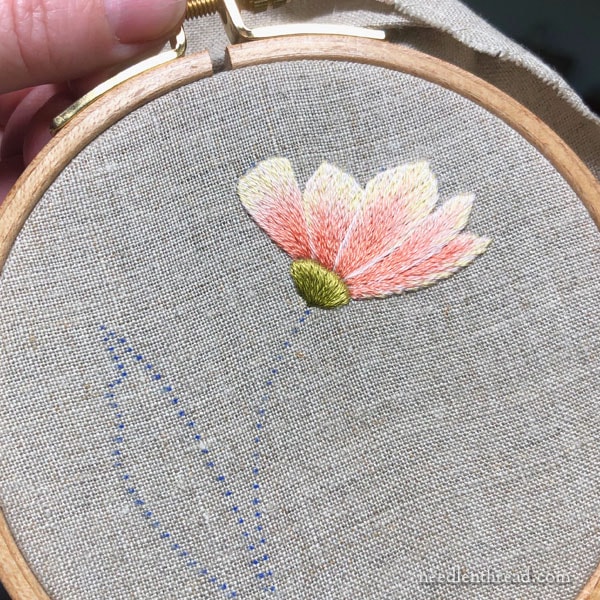
In needlepainting, contrast plays a key role. Although I like the flower pretty well, I can see certain areas that would have benefitted from a much greater contrast in the shading.
Specifically, wherever one petal seems to overlap another, the background petal could benefit from more contrast along the edge. This contrast could be presented by a neutral color just touched into the edge area, or by using a much darker shade of each of the colors involved along that edge.
Some sort of darkish neutral to form a shadow would probably be the easier approach.
Because this is needlepainting – which tends to be very forgiving – there’s a chance I can go back in and play with some darker shading along the edges of some of the petals.
I’m not sure I’m going to do that, but I might. Or I might just leave it for the next stitched model.
I’ll let you know what I do, so that we can make a comparison.
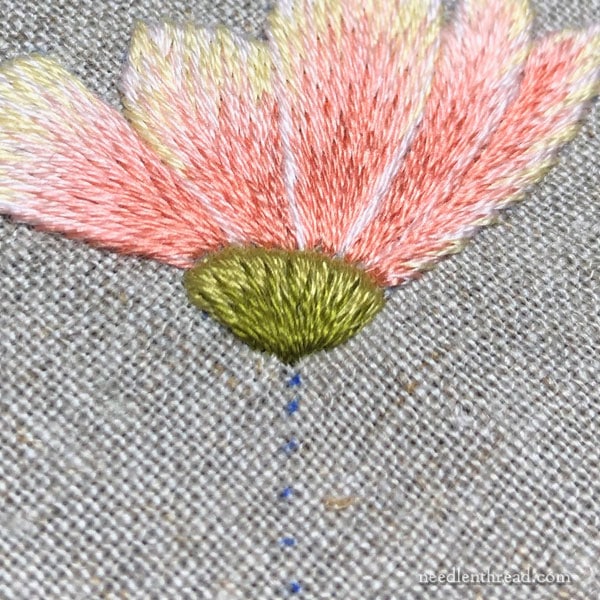
And here’s a little tip for you, to achieve a little extra lift on parts of your needlepainting.
You know how we often pad satin stitch, to raise it up off the fabric? You can do the same thing with needlepainting.
On the receptacle of the flower, or the little green bowl at the top of the stem, I stitched around the shape with a fine split stitch line, over which I normally would work the long and short stitch without doing anything else to the shape.
But for this element, which I wanted to be a little bit bulby or rounded at the top, I padded underneath the top third of the shape, too.
To do this, I worked horizontal lines of longer split stitch close together across the top third of the shape, inside the split stitch outline. I used the light green, since this is the part that I wanted to look a little more lifted and rounded compared to the rest of the shape.
I had intended to finish this whole flower on Monday. It’s still not finished! The stem is taking much longer than I intended, as I tested a couple ideas on it.
While working on the stem, my mind has been playing with the leaf. I have two different approaches in mind for it. Can’t wait to test them this weekend!
If you want to see the beginning of this flower, you can find my first article on it here.
Coming Up on Needle ‘n Thread
We’ve been having a great conversation on Thimbles over on my Needle ‘n Thread Community group on Facebook. with lots of input from group members on their use (or non-use) of thimbles when they stitch. I’ll be sharing some information about thimbles next week, discussing the what’s, why’s, and how’s with you.
In the studio, I’ve been fiddling with some new equipment, and once I have my processes down, I’ll have more Floral Corners towel sets available for you. While the e-book is always available (with the patterns in it), the towel sets are only available as I can prepare them. If you prefer to skip the transfer process (and who can blame you?!), I’ll have some ready for you soon! I’ll announce it here on the website when they’re available again, probably by the end of next week.
I hope you have a wonderful weekend with your needle and thread!



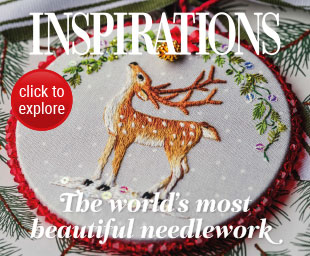

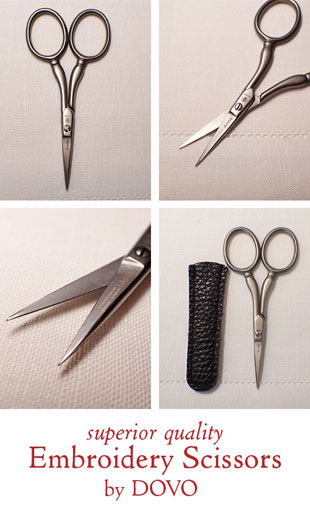
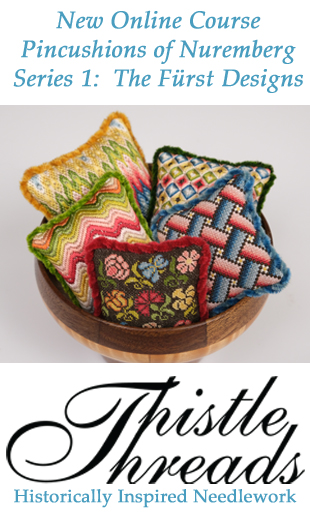
Dear Mary
I’m glad you had time for some stitching session and it was relaxing for you, A lovely piece of stitching and a very pretty design and I look forward to what you have in store for this collection I do hope it’s another e-book. Thanks for sharing your new project with as and for the techniques and photos. I never use a thimble as I find they get in the way of my stitching and I can’t get used to the feel of them on my fingers. I do hope you have a great weekend and are able to find time for some stitching sessions.
Regards Anita Simmance
Would love a picture of the padding you did on the flower. Thanks!
Fantastic!
Thanks Mary, I love these up-close stitching analyses, very informative! One thing I do wish, and this might just be clueless me and nobody else, is that a post describing stitching details would routinely specify how many strands of thread are being used. (And what type of thread if it’s not the default good old cotton floss.)
I know I should be able to tell from the photos how many strands are in a stitch, but somehow it doesn’t seem clear to me! And of course I can look around in previous posts for information about how many strands are used for which stitch, but an eentsy two- or three-word reminder right in the current post would be a help! (Somehow I can always remember that satin stitch is best with a single strand, and I think split stitch is supposed to use odd numbers of strands? As I said, maybe this particular cluelessness is unique to me!)